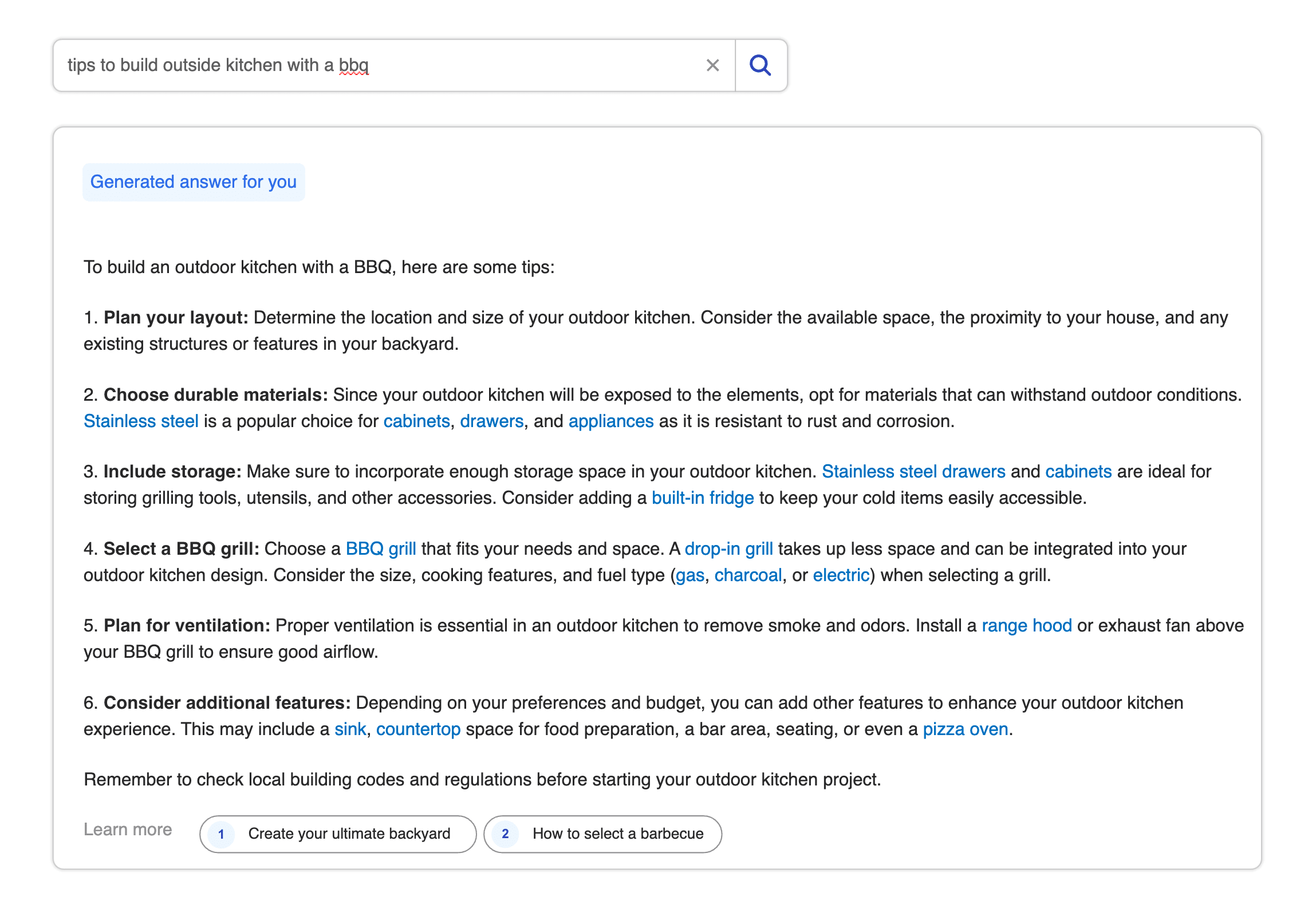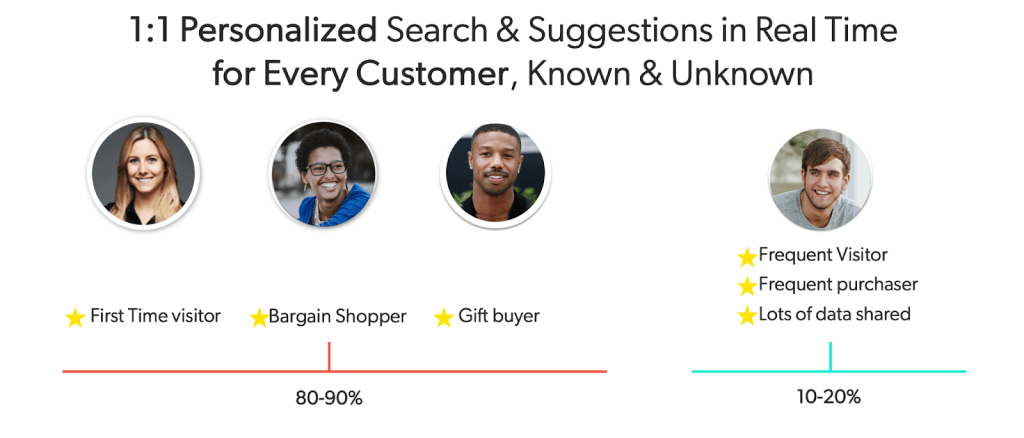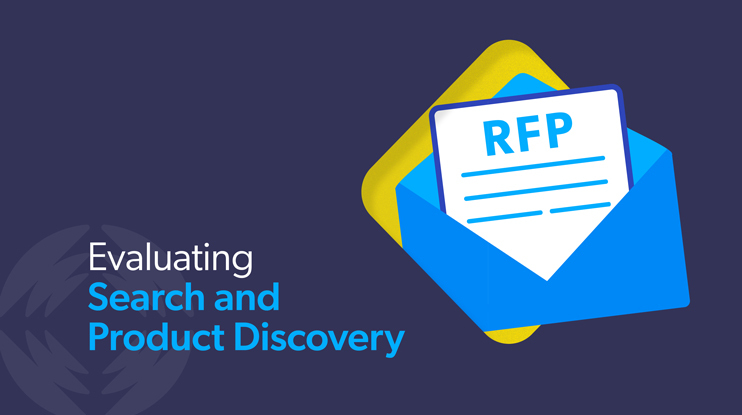In the market for a search and product discovery solution? Make sure you have everything you need to ask the right questions and make an informed decision for your company with a fine-tuned request for proposal (RFP). An RFP document outlines and describes a project for which businesses are seeking a desired IT solution from a prospective vendor.
To help you establish clear requirements, better assess what’s on the market, and find what best fits your business, we’ve created a customizable search and product discovery RFP template for you.
We’ll also provide a few considerations for assessing search and product discovery vendors. In line with leading industry analysts, we define search and product discovery as “software solutions that ingest product, customer, and logistical data and apply logic (via human-defined rules or machine learning models) to show products to shoppers.
“These solutions personalize that selection of products based on shoppers’ historical activities, their behaviors in the current session, and the goals or configurations set by the merchant.”
1. Tie your GenAI investments to ROI
In 2022, OpenAI introduced ChatGPT, bringing large language models (LLMs) and Generative AI (GenAI) into the public eye. This sparked excitement and interest in the technology. And it has set a higher standard for seamless, conversational experiences.
Today, search and product discovery solutions are expected to guide and inspire queries, offer curated filters, retrieve accurate results, provide rich answers, and ensure fast, reliable, and conversational interactions.
However, companies should focus on GenAI that is conducive to ROI, not GenAI for the sake of it. It’s important to focus on use cases that are most valuable. For example, according to research from the Boston Consulting Group, the most wanted GenAI feature in ecommerce is the ability to answer complex questions about products. Hence, it is critical to be able to empower customers to ask questions as part of their product research, and to be able to respond to questions such as, “what is the best lens for wildlife photography?”

As it turns out, though, while Generative AI offers new opportunities, not all implementations are created equal. Hallucinations raise significant concerns. Remain wary of solutions that use LLMs for content generation, as this is often just “LLM-washing.” These vendors don’t explain how they ground their answers in fact.
The real breakthrough has been Retrieval Augmented Generation (RAG), following the 2020 paper “Retrieval-Augmented Generation for Knowledge-Intensive NLP Tasks.” RAG addresses hallucinations by incorporating relevant data at query time. By retrieving and feeding an AI model with only pertinent information generates coherent answers. This grounds responses in fact and enables citations.
Implementing RAG is a complex engineering feat, though, so it’s key to confidently deploying generative answering at enterprise scale. Therefore, it is important to ask questions about strategies in place to mitigate and minimize the risk of errors and hallucinations.
2. Real-Time, 1:1 Personalization: Navigate the Landscape of Vendors with Caution
In 2024, 1:1 personalization is not only a powerful strategy for digital leaders but also behavior that is expected by customers. This concept isn’t new. As quoted by the Washington Post in 1998, Jeff Bezos said, “If we have 4.5 million customers, we shouldn’t have one store. We should have 4.5 million stores.” Since then, the personalization algorithms used by apps like TikTok, Netflix, and Spotify have been refined to perfection. Today, delivering experiences that are both relevant and personalized is considered the baseline.
The good news is that real-time 1:1 personalization is achievable and is being offered by some search and product discovery vendors. The somewhat less good news is that achieving this level of personalization is extremely challenging, and only a few vendors can truly offer it.
This complexity arises because brands and retailers aim to provide personalized experiences for each customer, yet typically, they can only do so for known and frequent purchasers, for which they have enough data points to leverage.
This presents a significant challenge; unless you’re Amazon, the majority of shoppers are not frequent visitors or purchasers on most websites.

Therefore, it’s crucial to inquire whether vendors possess the necessary data streaming and deep learning technology to facilitate 1:1 personalization in real-time. This technology is essential for delivering individualized experiences by leveraging clickstream and in-session data.
Regrettably, what many vendors label as personalization is merely basic segmentation. Furthermore, what some consider real-time personalization often amounts to chaotic re-ranking, misaligned with shopper intent. Additionally, most vendors struggle to effectively surface and re-rank new, niche, and long-tail products.
Asking the right questions in your RFP is crucial. Our template includes several pertinent questions that can help guide your inquiry.
3. Unleash the Power of Multi-Layered Relevance
AI should not only be integrated at every touchpoint of the customer journey but should also allow for the layering of multiple machine learning models. This is essential because relevance is multi-faceted and requires careful orchestration. Key aspects include the wisdom of the crowd, KPI optimization, semantic search, and 1:1 personalization.

Regrettably, many vendors still present a false dichotomy: choosing between personalizing experiences and search results or leveraging AI to optimize product rankings. Understanding the depth and breadth of AI capabilities offered by a search and product discovery vendor is crucial.
Many of the questions in the RFP template will help you identify vendors that cannot meet such critical requirements.
4. Purchase Search and Personalization from One Vendor
When preparing your RFP, don’t forget to ask questions about the potential vendor’s product recommendations capabilities.
Until recently, it was relatively common to purchase commerce search and recommendations from separate vendors. Luckily, digital leaders are now starting to realize that this would lead to fractured customer journeys and experiences.
They’re now acknowledging the connection between search and recommendations — and are realizing they should have purchased both from the same technology partner. Recommendations that truly drive tangible business outcomes in ecommerce require the ability to understand products as well as you understand people.
Buying search and recommendations from the same vendor means you can leverage search signals to improve the customer experience by serving more relevant content throughout their entire journey on your website.
It also makes it easier to increase the relevance of the commerce search experiences you provide. With 30% of ecommerce visitors using on-site search and converting between five to six times higher than non-site search visitors, saying that search is an important touchpoint is an understatement.
And given how important a touchpoint it is, you should inject powerful personalization capabilities into your search, too, showing different query suggestions and search results based on the shopper’s profile, interests, and preferences.
5. Not All Content Recommendations Are Created Equal
We’ve come a long way from the collaborative filtering that Amazon used so successfully. Personalized experience today can harness the power of deep learning to deliver the most relevant recommendations to shoppers.
Yet research from the Baymard Institute shows that most websites still struggle to deliver relevant recommendations. For instance, 52% of sites present cross-sells that are either completely irrelevant or based only on what other customers bought. Providing relevant recommendations isn’t straightforward — for instance, complementary and similar items must satisfy different logical relations. Delivering personalized recommendations is challenging when users are new or visit a website rarely.

Best-in-breed technology vendors offer ways to tackle even the thorniest challenges such as user cold start scenarios) leveraging artificial intelligence (AI) and machine learning (ML) to provide the most relevant, accurate and personalized recommendations. So, don’t forget to ask vendors about the technology that underlies their recommendations and how they address these obstacles.
Further, don’t forget to ask about vendors’ ability to offer content recommendations as well. Traditionally, many in ecommerce felt that content distracts and dilutes business goals; i.e., conversions. The truth is, content can enhance customer acquisition, decision-making, and conversions, depending on where that customer is in their buying journey.
6. Harness the Full Power of Analytics
Getting a search and product discovery solution up and running is step one. Step two is dissecting data from your customers’ interactions, so that you can create impactful experiences. An ecommerce search and product discovery solution should provide you with the means to not just curate those experiences, but measure their results.
But bear in mind that today’s customer journeys are growing increasingly complex. While you may want to use a curation engine to create consistent, tailored experiences across a multiplicity of touchpoints (think omnichannel personalization), deciphering performance and user behavior when dealing with convoluted journeys is a big task.
So, when selecting the questions to include in your RFP, ask vendors how their analytics solution handles this challenge and provide insights on behavior across multiple touchpoints. Keep in mind here that best-in-class solutions move beyond simplistic last-touch and first-touch attribution models that assign 100% of the credit for a conversion to a single customer journey touchpoint.

In addition, verify whether vendors offer easy-to-use dashboards that can provide ecommerce teams with a clear overview of key financial and website KPIs at any time.
Keep in mind that a holistic approach is important when it comes to ecommerce KPIs. Search and product discovery software should report and display performance based on several key metrics.
For instance, while you want to boost your Conversion Rate, measuring KPIs in isolation can be misleading and even have the opposite impact of what you were aiming for. You may see your Average Order Value increasing, only to find that the Conversion Rate is tanking.
Or alternatively, during some campaigns, you may have increases in Conversion Rate due to some promotions and discounts, which are accompanied by a decrease in Average Order Value.
Metrics simply show symptoms; different symptoms become visible through different metrics.
7. Always Be Testing
Digital giants such as Google, Amazon or Netflix have gotten to where they are by listening to their customers through rigorous data collection and A/B testing. But conducting systematic, rigorous A/B testing is not straightforward.
Best-in-breed search and product discovery vendors effectively balance user friendliness and scientific rigor, for instance by making it easy to experiment with large enough samples and to schedule tests to ensure random testing and avoid day-of-the-week effects.

However, to ensure conclusions are trustworthy, it’s critical that search and product discovery solutions also report on the experimental results’ statistical significance. This is important because it gives you confidence that the changes you make to your website or app actually have a positive impact on your conversion rate and other metrics.
Your metrics and numbers can fluctuate wildly from day to day, and statistical analysis provides a sound mathematical foundation for making business decisions and eliminating false positives.
8. Validate and Understand Vendors’ AI Claims
Most vendors tout AI capabilities, but not all AI is created equal. Buyers should thus look for best-in-breed vendors with a track record of innovation as they are likely to consistently release new features and develop critical capabilities to help thrive in the ever-evolving ecommerce world.
So, don’t forget to ask vendors about their IP strategy and to show you evidence of peer reviewed research or patents. For example, personalization vendors such as Coveo constantly publish research alongside Netflix, YouTube, and other tech giants.
However, there’s more that needs to be asked. For instance, make sure to ask about the model optimization techniques used to improve the performance of machine learning models. Further, bear in mind that AI and ML should not be reduced to deep learning, as there are different approaches and techniques available.
It’s important to understand what AI/ML capabilities vendors are offering and how these approaches are appropriate for the use cases at hand.
9. Assess Enterprise Readiness
Enterprise readiness involves elements from scalability to security requirements. Core competencies of a modern enterprise platform allow you to change provisioned resources according to fluctuations in demand and to deploy the product in different regions. Best-in-class solutions help you avoid resource under- and overuse, while maintaining quality. They also reduce latency, improve performance, and ensure compliance no matter where in the world a user is located.
So, in compiling your RFP document, ask whether the solution addresses special initiatives like Black Friday peak events. Ask vendors to define their scalability approaches.
Moreover, since search and product discovery solutions that are secure by design must be compliant with many norms, certifications, and regulations, include questions about the vendors’ certifications. Similarly, try and understand vendors’ capabilities and approaches to secure customer data at all layers. In particular, ask how solutions logically partition, encrypt, and safeguard data to mitigate the risk of data breach and support compliance.
10. Look at the Product — But Don’t Overlook the Company
While it’s obviously critical to try and understand products, it would be a mistake not to include questions about the company as well. For instance, to address uncertainties, buyers should choose vendors that demonstrate acuity in innovation, competence, and ethics when pursuing technologies for personalization. Include company overview questions that investigate their product vision and planned enhancements as well. As shown by research from Gartner, commitments to innovation matter highly: an enterprise is 2.7 times more likely to be a top-performing organization when it increases innovation funding.

Further, to minimize the risk of vendor failure and obsolescence, reviewing vendors’ income statements can be of utmost importance. For instance, selecting a publicly traded company might be a preferable choice for those looking for a partner with greater access to financial resources to invest in innovation. Keep in mind that there are tangible and undesirable results for ineffectively managing risk: namely threatened business profitability and sustainability, financial loss, violated contracts and reputation impact.
Download Your RFP Template and Vendor Scorecard
If you’ve read up until this point, you’ve probably noted the critical questions and capabilities your RFP document should ask. However, because designing an RFP is both a delicate and difficult process, we’ve created a downloadable RFP tool for you.
Use this RFP template as a starting point to easily compare the basic functionalities of search and product discovery solutions. With it, you’ll handily identify competitive differentiators between them, as well as enhanced functionality that can help your business stand out.
The spreadsheet contains a list of 200 questions (tab 1) to ask relevant enterprise-class vendors as part of your company’s selection process. Of course, feel free to add, edit, or remove any queries to customize the template to your specific ecommerce project.
Vendors can specify whether they satisfy a specific requirement in the “Supported by vendor?” column and provide further information in the “Comments” column. Once vendors have shared their answers, you can simply paste them in their “Vendor Scorecard.”
The spreadsheet automatically assigns scores based on the options selected by the vendor. The last tab is a “Score Sheet” to easily compare weighted scores, strengths, and weaknesses to identify the vendor and solution that best suit your ecommerce project. As before, change the weights assigned to different capabilities as required by your project.




